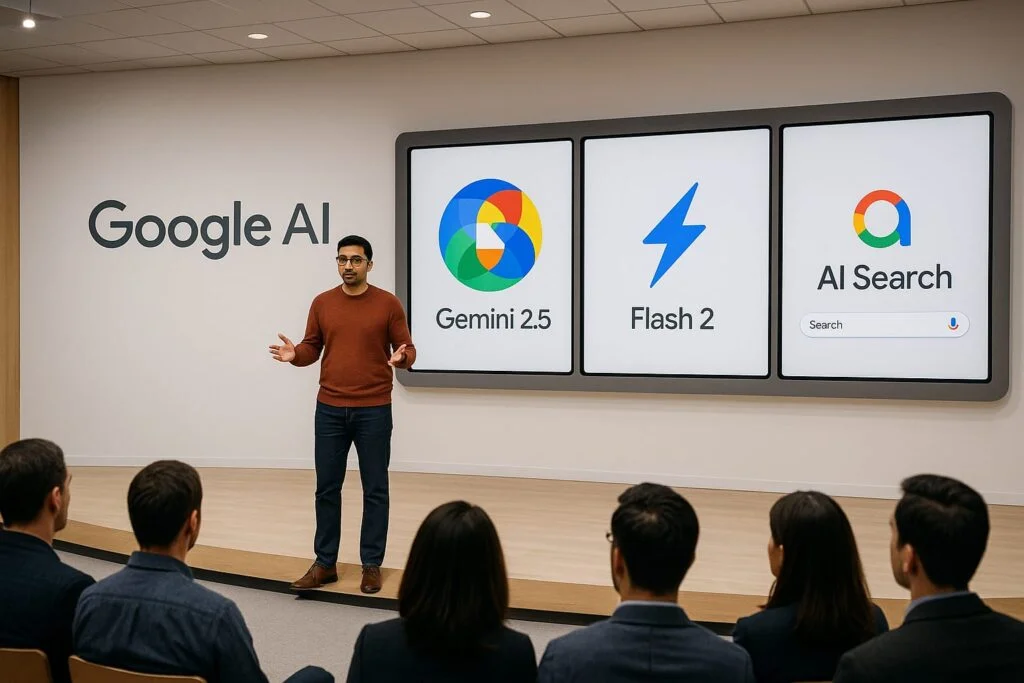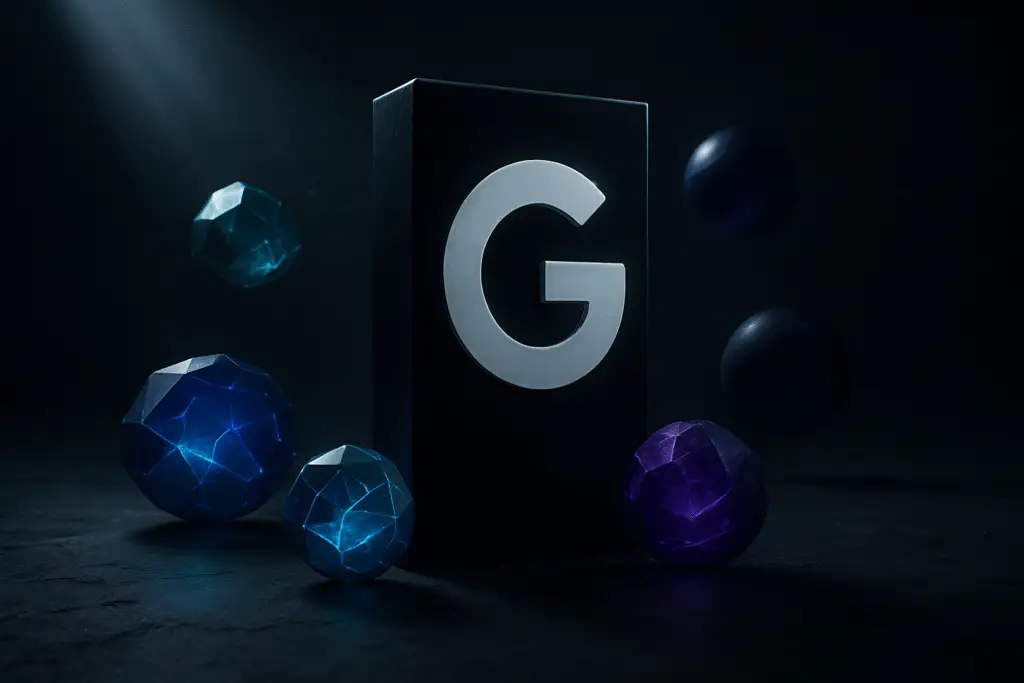Imagine having an AI that thinks like a researcher, speaks like a translator, and creates like an artist—all in real-time.
“Google AI” is where breakthroughs are no longer limited to the lab—they’re now in your pocket, your browser, and your creative workflow.
From productivity powerhouses like Gemini 2.5 to the breathtaking realism of Gemini Diffusion, Google is pushing boundaries faster than ever. But these tools aren’t just impressive—they’re deeply integrated into how we work, communicate, and create.
Let’s take a deep dive into five of the most groundbreaking Google AI’s tools that are turning science fiction into everyday function.

1. Gemini 2.5: Google AI’s Master Stroke
Google’s Gemini 2.5, launched in early 2025, marks a serious upgrade in multimodal intelligence. Unlike its predecessors, it can process and reason across text, images, code, audio, and video simultaneously.
It also scores a state-of-the-art 18.8% across models without tool use on Humanity’s Last Exam, a dataset designed by hundreds of subject matter experts to capture the human frontier of knowledge and reasoning.
In addition to its strong performance on academic benchmarks, the new 2.5 Pro is now leading the popular coding leaderboard, WebDev Arena, with an ELO score of 1415.
💡 What Makes Gemini 2.5 Unique?
- Native integration with Google Workspace: It can generate full presentations, summarize email threads, and even draft documents based on spreadsheets or voice notes.
- Memory & context retention: Think of it as a digital research partner who remembers your workflow and preferences over time.
- Multi-modal learning: For example, you can upload a chart, ask a question about the trends, and receive insights instantly—something we’ve used repeatedly during team brainstorming sessions.
Real-world impact: When preparing for a startup pitch recently, I uploaded a messy Google Doc and some screenshots into Gemini. It created a pitch deck outline, rewrote the intro for clarity, and suggested design aesthetics—within minutes.
🔗 Explore Gemini AI in Workspace

2. Google AI’s Realtime Speech Translation: Breaking Language Barriers Instantly
Imagine speaking with someone across the globe—without a shared language—and understanding them in real time. That’s what Google’s Realtime Speech Translation, now integrated in Android and Pixel devices, is achieving. Take a look at this YouTube video how powerful Google AI’s Realtime Speech Translation really is.
🌍 Key Features:
- Live bilingual subtitles for in-person conversations.
- Works in over 45 languages and adapts tone/context better than previous iterations.
- Integrated with Wear OS and Pixel Buds, allowing hands-free communication.
I tested this at an international cafe in Amsterdam—spoke in English, received real-time translation in Dutch, and the response came back translated instantly in my earbuds. It was like wearing the future.
🔗 How Google Translate AI works
3. Project Mariner: AI That Understands the Web’s Nuances
Project Mariner isn’t getting the spotlight it deserves—but it’s quietly revolutionizing how AI interprets web data.
⚓ What is Project Mariner?
It’s Google AI’s behind-the-scenes initiative focused on scaling large language models to better understand nuanced, factual web content in real time. Unlike traditional models, Mariner can cross-reference live data and validate sources—minimizing hallucinations.
| Feature | Traditional AI | Project Mariner |
|---|---|---|
| Updates | Static knowledge | Real-time facts |
| Source verification | Limited | Cross-checked |
| Web depth | Surface-level | Context-rich |
“We’re basically allowing users to type requests into their web browser and have Mariner take actions,” project manager Jaclyn Konzelmann tells the New York Times.
U.S. subscribers to Google’s new $249.99-per-month AI Ultra plan will get access to Project Mariner, and the company says support for more countries is coming soon.
🔗 Read more about AI and real-time data
4. Gemini Diffusion: Google AI’s Answer to MidJourney & DALL·E
In the ever-growing world of generative art, Gemini Diffusion is Google’s fresh, powerful contender. Built on advanced diffusion models, it can generate hyper-realistic and artistic visuals from simple prompts—and it’s seamlessly integrated with Google Photos and Android. We are talking about an average of 1479 tokens/second processing, which means a blink of an eye and BOOM!! In layman’s terms, it’s all the Harry Potter books in 22 minutes READ and SUMMARIZED!!.
🎨 Why It Stands Out:
- Fine-grained control: Adjust lighting, emotion, and even art style.
- Multimodal prompts: Upload a photo and ask it to turn it into a watercolor scene or cinematic frame.
- Creative assistant: Especially useful for designers, bloggers, and content creators.
As a blogger, I use Google AI’s Gemini Diffusion to visualize abstract ideas. A recent post on climate tech featured an AI-generated infographic that perfectly visualized carbon capture—it was more engaging than stock art could ever be.
| Tool | Output Quality | Style Range | Integration |
|---|---|---|---|
| MidJourney | High | Broad | Standalone |
| DALL·E | Medium | Moderate | Some apps |
| Gemini Diffusion | High | Diverse + Realistic | Deep with Google apps |
🔗 Discover Gemini Diffusion Art
5. Google AI Mode: Android’s Smartest Upgrade Yet
The newly launched AI Mode in Android 15 transforms your device into an intelligent assistant that anticipates your needs It’s been almost over a year since we have been getting Gemini search results for our web searches on top of our window, but now Google has taken it one step further by adding AI mode for searches, which will get us personalized results for our queries .
🔧 Features of AI Mode:
- Query Fan: Google AI’s AI Mode uses a query fan-out technique, breaking down your question into subtopics and issuing a multitude of queries simultaneously on your behalf.
- Personalized routines: Based on daily habits—e.g., turning on reading mode, dimming lights, or muting notifications.
- On-device intelligence: Processes sensitive data locally using Google’s Tensor G3 chip, ensuring privacy.
I’ve used AI Mode during travel—landing in a new city and getting contextual suggestions for language translation, map routes, and weather-based outfit tips, all without opening a single app.
video source https://blog.google/products/search/google-search-ai-mode-update/#ai-mode-search
🔍 What Do These Tools Say About the Future of Google AI?
Google isn’t just releasing tools—it’s creating an ecosystem where AI complements your everyday activities without needing special prompts or configurations. Here’s why that matters:
- Seamless User Experience: Each tool integrates into existing apps (Docs, Translate, Photos), removing friction.
- Personalization at Scale: AI learns from how you work—not just what you say.
- Safety & Accuracy First: Tools like Project Mariner ensure fewer hallucinations and higher factual reliability.
🧠 Key Takeaways
| Tool | Use Case | Standout Feature |
|---|---|---|
| Gemini 2.5 | Productivity, Research | Multimodal + Workspace integrated |
| Realtime Speech Translation | Travel, Accessibility | Live, contextual subtitles |
| Project Mariner | Knowledge Validation | Real-time web comprehension |
| Gemini Diffusion | Visual Creation | Prompt-to-image realism |
| AI Mode | Mobile UX | Predictive personalization |
✅ Final Thoughts: The Age of Embedded Intelligence
The age of Google AI isn’t about standalone bots—it’s about invisible intelligence woven into everything we do. Whether you’re writing, translating, traveling, or creating, these tools are turning science fiction into tap-and-go functionality.
Discover more from blogbooze
Subscribe to get the latest posts sent to your email.




Good content
Informative
Hello, Neat post. There’s an issue together with your ite in internet explorer, may check
this? IE still is the market chief annd a big section of folks will omit your fantastic
writing due to this problem. http://Boyarka-inform.com/
Nice blog here Also your site loads up fast What host are you using Can I get your affiliate link to your host I wish my web site loaded up as quickly as yours lol